The Intel Kaby Lake-X i7 7740X and i5 7640X Review: The New Single-Threaded Champion, OC to 5GHz
by Ian Cutress on July 24, 2017 8:30 AM EST- Posted in
- CPUs
- Intel
- Kaby Lake
- X299
- Basin Falls
- Kaby Lake-X
- i7-7740X
- i5-7640X
Benchmarking Performance: CPU System Tests
Our first set of tests is our general system tests. These set of tests are meant to emulate more about what people usually do on a system, like opening large files or processing small stacks of data. This is a bit different to our office testing, which uses more industry standard benchmarks, and a few of the benchmarks here are relatively new and different.
All of our benchmark results can also be found in our benchmark engine, Bench.
PDF Opening
First up is a self-penned test using a monstrous PDF we once received in advance of attending an event. While the PDF was only a single page, it had so many high-quality layers embedded it was taking north of 15 seconds to open and to gain control on the mid-range notebook I was using at the time. This put it as a great candidate for our 'let's open an obnoxious PDF' test. Here we use Adobe Reader DC, and disable all the update functionality within. The benchmark sets the screen to 1080p, opens the PDF to in fit-to-screen mode, and measures the time from sending the command to open the PDF until it is fully displayed and the user can take control of the software again. The test is repeated ten times, and the average time taken. Results are in milliseconds.
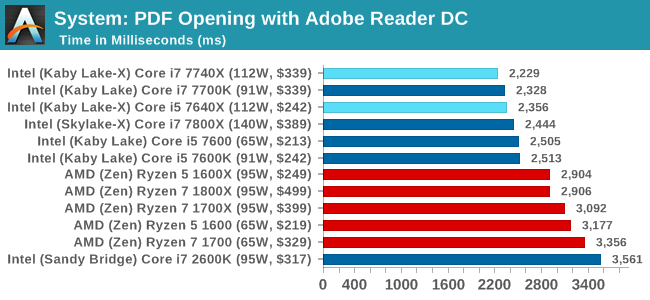
PDF opening is all about single thread frequency and IPC, giving the win to the new KBL-X chips.
FCAT Processing: link
One of the more interesting workloads that has crossed our desks in recent quarters is FCAT - the tool we use to measure stuttering in gaming due to dropped or runt frames. The FCAT process requires enabling a color-based overlay onto a game, recording the gameplay, and then parsing the video file through the analysis software. The software is mostly single-threaded, however because the video is basically in a raw format, the file size is large and requires moving a lot of data around. For our test, we take a 90-second clip of the Rise of the Tomb Raider benchmark running on a GTX 980 Ti at 1440p, which comes in around 21 GB, and measure the time it takes to process through the visual analysis tool.
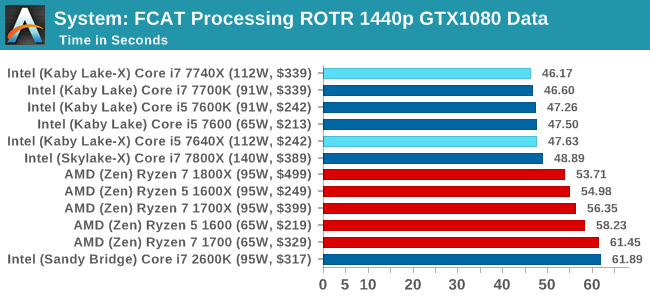
FCAT similarly favors frequency and IPC. For this sort of workload, the Core i7 is the best chip to get.
3D Movement Algorithm Test v2.1: link
This is the latest version of the self-penned 3DPM benchmark. The goal of 3DPM is to simulate semi-optimized scientific algorithms taken directly from my doctorate thesis. Version 2.1 improves over 2.0 by passing the main particle structs by reference rather than by value, and decreasing the amount of double->float->double recasts the compiler was adding in. It affords a ~25% speed-up over v2.0, which means new data.
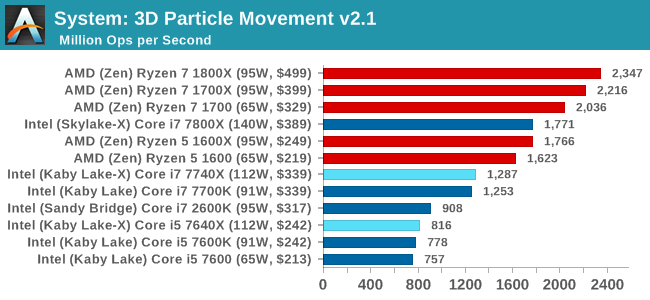
As 3DPM expands into several threads, the new quad-core parts will easily get trounced here by AMD's 8-cores for the same price. The Core i7-7800X puts on a good showing, as per core Intel's chips give a higher score.
DigiCortex v1.20: link
Despite being a couple of years old, the DigiCortex software is a pet project for the visualization of neuron and synapse activity in the brain. The software comes with a variety of benchmark modes, and we take the small benchmark which runs a 32k neuron/1.8B synapse simulation. The results on the output are given as a fraction of whether the system can simulate in real-time, so anything above a value of one is suitable for real-time work. The benchmark offers a 'no firing synapse' mode, which in essence detects DRAM and bus speed, however we take the firing mode which adds CPU work with every firing.
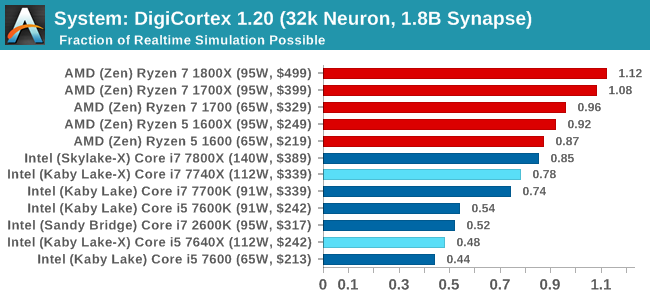
DigiCortex likes a bit of everything: cores, threads, IPC, frequency, uncore frequency, and memory frequency. The Core i7 parts roughly double the Core i5s due to the thread count, and also the AMD Ryzen parts skip ahead as well due to having double the threads to the Core i7.
Agisoft Photoscan 1.0: link
Photoscan stays in our benchmark suite from the previous version, however now we are running on Windows 10 so features such as Speed Shift on the latest processors come into play. The concept of Photoscan is translating many 2D images into a 3D model - so the more detailed the images, and the more you have, the better the model. The algorithm has four stages, some single threaded and some multi-threaded, along with some cache/memory dependency in there as well. For some of the more variable threaded workload, features such as Speed Shift and XFR will be able to take advantage of CPU stalls or downtime, giving sizeable speedups on newer microarchitectures.
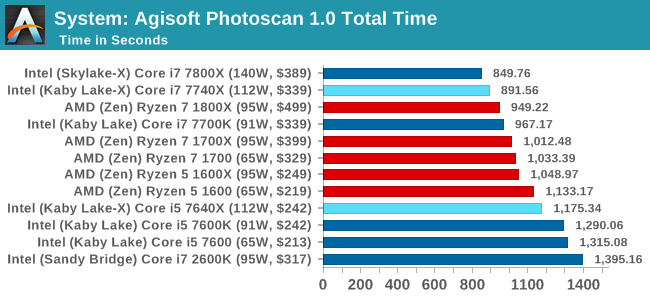
Agisoft is like a Formula 1 race circuit: the long fast straights and techical corners make it a nightmare to have the technology to be the best at both, and Photoscan has enough serial code for high single thread performance to take advantage but also massively parallel sections where having 12-18 threads makes a difference. Despite having half the threads, the single core performance of the Core i7-7740X makes it pull ahead of the Ryzen 7 chips, but when comparing the four threads of the Core i5-7640X to the twelve threads of the Ryzen 5 processors, having 12 threads wins.










176 Comments
View All Comments
Alistair - Monday, July 24, 2017 - link
I look at it this way: in 2016 I bought a 6600k for $350 CAD. In 2017 I bought a Ryzen 1700 for $350 CAD. Overall speed increase 240%. So AMD delivered 240 percent more performance at the same price in one year. Intel continues to deliver less than 10 percent per dollar. I could care less if the single performance is the same.Call me next time Intel releases a chip a year later that is 240 percent faster for the same price.
Hurr Durr - Monday, July 24, 2017 - link
So you bought yourself inferior IPC and a sad attempt at ameliorating it by piling up cores, and now have to cope with this through wishful thinking of never materializing performance percents. Classic AMD victim behavior.Alistair - Monday, July 24, 2017 - link
First of all, stop using IPC, an expression you don't understand. Use single core performance. In almost every single benchmark I see dramatic speed improvements. I'm comparing the i5 with a Ryzen 1700 as they were the same cost. People harping over the i7-7700k apparantly didn't notice the 1700 selling for as low as $279 USD.Also get higher fps in almost every single game (Mass Effect Andromeda, Civilization and Overwatch in particular).
Alistair - Tuesday, July 25, 2017 - link
I have tremendous respect for Ian, whose knowledge and integrity is of the highest order. I just think some of his words in this review lose the plot. As he said, "it would appear Intel has an uphill struggle to convince users that Kaby Lake-X is worth the investment". He should have emphasized that a little more.In Canada, Ryzen 1700 plus motherboard = $450. i5 (not i7) plus motherboard is $600. Yes, $150 dollars more!
Intel has 20 percent faster single core performance and yet Ryzen is 2.4 times (+140 percent) faster overall... Numbers should speak for themselves if you don't lose the plot. I agree single threaded performance is very important when the divergence is large, such as Apple's A10 vs Snapdragon 835, or the old Bulldozer. But the single threaded gap has mostly closed and a yawning gulf has opened up in total price/performance. Story of the year!
Hurr Durr - Tuesday, July 25, 2017 - link
Extolling price slashing right after launch, boy you`re on a roll today.silverblue - Tuesday, July 25, 2017 - link
I think you should prove why you think Intel is the superior buy, instead of just trolling and not actually providing any rationale behind your "arguments".On Amazon.co.uk right now, there are four Ryzen and one FX CPU in the top 10. Here's the list (some of the recommended retail price values are missing or a bit - in the case of the 8350 - misleading):
1) i7-7700K £308.00; RRP £415.99
2) R5 1600 £189.19; RRP £219.95
3) R7 1700 £272.89; RRP £315.95
4) i5-7600K £219.99; RRP £?
5) i5-7500 £173.00; RRP £?
6) FX-8350 £105.50; RRP £128.09
7) i5-6500 £175.09; RRP £?
8) R5 1500X £165.99; RRP £189.98
9) Pentium G4400 £48.90; RRP £?
10) R5 1600X £215.79; RRP £249.99
There must be a ton of stupid people buying CPUs now then, or perhaps they just prefer solder as their thermal interface material of choice.
Advantages for Intel right now: clock speed; overclocking headroom past 4 GHz; iGPU (not -X CPUs)
Disadvantages for Intel right now: price; limited availability of G4560; feature segmentation (well, that's always been a factor); overall platform cost
An AMD CPU would probably consume similar amounts of power if they could be pushed past 4.1GHz so I won't list that as a disadvantage for Intel, nor will I list Intel's generally inferior box coolers as not every AMD part comes with one to begin with.
The performance gap in single threaded workloads at the same clock speed has shrunk from 60%+ to about 10%, power consumption has tumbled, and it also looks like AMD scales better as more cores are added. Unless you're just playing old or unoptimised games, or work in a corporate environment where money is no object, I don't see how AMD wouldn't be a viable alternative. That's just me, though - I'm really looking forward to your reasons.
Gothmoth - Tuesday, July 25, 2017 - link
no first of = stop arguing with stupid trolls...prisonerX - Monday, July 24, 2017 - link
I can double my IPC by having another core. Are you really that dumb?Hurr Durr - Tuesday, July 25, 2017 - link
AMD victim calling anyone dumb is peak ironing. You guys are out in force today, does it really hurt so bad?wira123 - Tuesday, July 25, 2017 - link
yeah intel victim is in full force as well today, which is indeed ironic